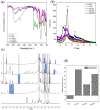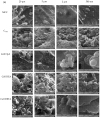Synthesis, Characterization and Cytotoxicity Studies of Aminated Microcrystalline Cellulose Derivatives against Melanoma and Breast Cancer Cell Lines
- PMID: 33182562
- PMCID: PMC7696900
- DOI: 10.3390/polym12112634
Synthesis, Characterization and Cytotoxicity Studies of Aminated Microcrystalline Cellulose Derivatives against Melanoma and Breast Cancer Cell Lines
Abstract
Cellulose based materials are emerging in the commercial fields and high-end applications, especially in biomedicines. Aminated cellulose derivatives have been extensively used for various applications but limited data are available regarding its cytotoxicity studies for biomedical application. The aim of this study is to synthesize different 6-deoxy-amino-cellulose derivatives from Microcrystalline cellulose (MCC) via tosylation and explore their cytotoxic potential against normal fibroblasts, melanoma and breast cancer. 6-deoxy-6-hydrazide Cellulose (Cell Hyd) 6-deoxy-6-diethylamide Cellulose (Cell DEA) and 6-deoxy-6-diethyltriamine Cellulose (Cell DETA) were prepared and characterized by various technologies like Fourier transform infrared spectroscopy-attenuated total reflectance (FTIR-ATR), nuclear magnetic resonance spectroscopy (NMR), X-ray diffractogram (XRD), Scanning Electron microscopy (SEM), Elemental Analysis and Zeta potential measurements. Cytotoxicity was evaluated against normal fibroblasts (NIH3T3), mouse skin melanoma (B16F10), human epithelial adenocarcinoma (MDA-MB-231) and human breast adenocarcinoma (MCF-7) cell lines. IC50 values obtained from cytotoxicity assay and live/dead assay images analysis showed MCC was non cytotoxic while Cell Hyd, Cell DEA and Cell DETA exhibited noncytotoxic activity up to 200 μg/mL to normal fibroblast cells NIH3T3, suggesting its safe use in medical fields. The mouse skin melanoma (B16F10) are the most sensitive cells to the cytotoxic effects of Cell Hyd, Cell DEA and Cell DETA, followed by human breast adenocarcinoma (MCF-7). Based on our study, it is suggested that aminated cellulose derivatives could be promising candidates for tissue engineering applications and in cancer inhibiting studies in future.
Keywords: MCC; aminated cellulose; breast cancer cell lines; cellulose; cytotoxicity; melanoma; tosylated cellulose.
Conflict of interest statement
The authors declare no conflict of interest.
Figures







Similar articles
-
6-deoxy-aminocellulose derivatives embedded soft gelatin methacryloyl (GelMA) hydrogels for improved wound healing applications: In vitro and in vivo studies.Int J Biol Macromol. 2021 Aug 31;185:419-433. doi: 10.1016/j.ijbiomac.2021.06.112. Epub 2021 Jun 21. Int J Biol Macromol. 2021. PMID: 34166695
-
Isolation and characterization of microcrystalline cellulose from roselle fibers.Int J Biol Macromol. 2017 Oct;103:931-940. doi: 10.1016/j.ijbiomac.2017.05.135. Epub 2017 May 23. Int J Biol Macromol. 2017. PMID: 28549863
-
Preparation and characterization of biocomposite packaging film from poly(lactic acid) and acylated microcrystalline cellulose using rice bran oil.Int J Biol Macromol. 2018 Oct 15;118(Pt A):1090-1102. doi: 10.1016/j.ijbiomac.2018.06.076. Epub 2018 Jun 18. Int J Biol Macromol. 2018. PMID: 29920370
-
Cytotoxic properties of the anthraquinone derivatives isolated from the roots of Rubia philippinensis.BMC Complement Altern Med. 2018 Jul 3;18(1):200. doi: 10.1186/s12906-018-2253-2. BMC Complement Altern Med. 2018. PMID: 29970094 Free PMC article.
-
Micro and nanocrystalline cellulose derivatives of lignocellulosic biomass: A review on synthesis, applications and advancements.Carbohydr Polym. 2020 Dec 15;250:116937. doi: 10.1016/j.carbpol.2020.116937. Epub 2020 Aug 16. Carbohydr Polym. 2020. PMID: 33049849 Review.
Cited by
-
Antimicrobial Activity of Cellulose Based Materials.Polymers (Basel). 2022 Feb 14;14(4):735. doi: 10.3390/polym14040735. Polymers (Basel). 2022. PMID: 35215647 Free PMC article.
-
Comparative Study of Crystallization, Mechanical Properties, and In Vitro Cytotoxicity of Nanocomposites at Low Filler Loadings of Hydroxyapatite for Bone-Tissue Engineering Based on Poly(l-lactic acid)/Cyclo Olefin Copolymer.Polymers (Basel). 2021 Nov 9;13(22):3865. doi: 10.3390/polym13223865. Polymers (Basel). 2021. PMID: 34833163 Free PMC article.
-
Unveiling the Potential of Protein-Based Sustainable Antibacterial Materials.Probiotics Antimicrob Proteins. 2025 Apr;17(2):737-762. doi: 10.1007/s12602-024-10381-6. Epub 2024 Oct 18. Probiotics Antimicrob Proteins. 2025. PMID: 39422822 Review.
-
Inorganic/organic combination: Inorganic particles/polymer composites for tissue engineering applications.Bioact Mater. 2023 Jan 11;24:535-550. doi: 10.1016/j.bioactmat.2023.01.003. eCollection 2023 Jun. Bioact Mater. 2023. PMID: 36714332 Free PMC article.
-
Diaminated Cellulose Beads as a Sustainable Support for Industrially Relevant Lipases.ACS Sustain Chem Eng. 2024 May 8;12(20):7703-7712. doi: 10.1021/acssuschemeng.3c07849. eCollection 2024 May 20. ACS Sustain Chem Eng. 2024. PMID: 38783841 Free PMC article.
References
-
- Kim S. Competitive Biological Activities of Chitosan and Its Derivatives: Antimicrobial, Antioxidant, Anticancer, and Anti-Inflammatory Activities. Int. J. Polym. Sci. 2018;2018:1–13. doi: 10.1155/2018/1708172. - DOI
-
- El-Saied H., Basta A., Barsoum B.N., Elberry M.M. Cellulose membranes for reverse osmosis Part I. RO cellulose acetate membranes including a composite with polypropylene. Desalination. 2003;159:171–181. doi: 10.1016/S0011-9164(03)90069-5. - DOI
-
- Heinze T., Pfeifer A., Koschella A., Schaller J., Meister F. Solvent-free synthesis of 6-deoxy-6-(ω-aminoalkyl) amino cellulose. J. Appl. Polym. Sci. 2016;133 doi: 10.1002/app.43987. - DOI
LinkOut - more resources
Full Text Sources
Miscellaneous

